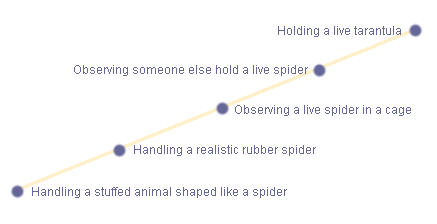
The Behavioural Approach To Treating Phobias – Systematic Desensitisation Including Relaxation And The Use Of Hierarchy; Flooding
March 23, 2017 - Paper 1 Introductory Topics in Psychology | Psychopathology
Description, AO1:
Behavioural Therapy for Treating Phobias
(1) Systematic Desensitisation (SD)
Used for Treating:
- Phobias
- OCD
How it works:
- Based on Classical conditioning. This therapy is directed at changing a previously learnt maladaptive response (e.g., an emotional behaviour such a fear or anxiety) to a new adaptive response (e.g., relaxation).
Systematic desensitisation is successful because of the following 2 key factors
- The key concept of SD is reciprocal inhibition. This simply means that it is impossible for a person to feel two opposite emotions, e.g., fear and relaxation, at the same time.
- It is a form of counter-conditioning (reverse learning) the individual learns to pair the feared object/ situation with relaxation rather than anxiety.
For example, a person who has a spider phobia will have previously learnt to feel afraid when a spider is present and so the therapist systematically teaches the person a new response to the spider.
How it works:
- Client is taught deep relaxation techniques (deep breathing, relaxing muscles etc)
- The client and therapist work to create a hierarchy of increasingly fearful situations.
- The client firstly learns to associate (Classical conditioning) the pleasant relaxation with the least fear-provoking situation at the bottom of the hierarchy (e.g. for someone with a spider phobia this could involve simply looking at a picture of a spider). Once this is achieved, the client is encouraged, to systematically make step by step progress up the hierarchy; associating a new relaxed response with the fearful situation at each stage.
- The aim of SD is that eventually the client will be able to associate the most fearful situation at the top of the hierarchy with a relaxed response (e.g. for a client with a spider phobia this could be finding a t
 arantula in their bed).
arantula in their bed).
See the image on the right as an example of a heirarchy that may be used by a client undergoing Systematic Desensitisation.
(2) Flooding:
Flooding (also known as implosion) works on the main assumptions of the Behavioural Approach and Systematic Desensitisation (i.e. still operates under the idea of Counter-Conditioning), however, instead of operating on the step-by-step approach of the hierarchy to tackle the phobia patients go straight to the top of the hierarchy and imagine or have direct contact with their most feared scenarios. The idea is that the patient cannot make their usual avoidance responses and anxiety peaks at such high levels it cannot be maintained and eventually subsides.
Evaluation, AO3 of Behavioural Treatments of Phobias:
Strengths:
(1) POINT: A strength of Systematic Desensitisation is that it can be a very effective treatment. EXAMPLE: Barlow et al (2002) found success rates of between 60 and 90 per cent for specific types of phobias when individuals committed to the phobias and stuck to the regime. EVALUATION: This is positive because this therapy is effective at removing the symptoms of a disorder without the need for potentially damaging drugs (anti-anxiety drugs would be given within the Biological approach) which often cause many side effects (e.g. drowsiness, risk of addiction).
Weaknesses:
(1) POINT: Behavioural therapies such as SD and Flooding raise major ethical issues. EXAMPLE: For example, clients are subjected to their most feared situations in techniques such as SD/Flooding causing some clients to experience very high levels of distress. EVALUATION: This is a weakness because clients may not stay in therapy and may actually leave the therapeutic situation in a worse state than when they began due to the potential for high levels of distress.
(2) POINT: Behavioural techniques are not effective for more complex phobias. EXAMPLE: Ohman et al (1975) suggested SD might not be effective in treating anxieties that have an underlying survival component e.g. fear of heights/snakes. EVALUATION: This is a problem because by only focussing on the removal of symptoms (as the behavioural therapists do) rather than in identifying the underlying cause (as Biological and Cognitive therapists do), a disorder may only be removed temporarily and may reoccur at a later date ~ often even worse than before (this is called symptom substitution e.g., a dog phobia may be replaced with a fear of going out of the house).


